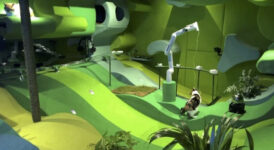
Would You Trust Robot to Look After Your Cat?
Scientists from the University of Nottingham and artists from Blast Theory have created Cat Royale, a multispecies world centered around a bespoke enclosure in which three cats and a robot arm coexist for six hours a day during a twelve-day installation.
“From cleaning our homes, to mowing our lawns, to delivering shopping and couriering items around hospitals, robots are finding their place in daily life,” said University of Nottingham’s Professor Steve Benford and colleagues.
“As they do so, they will inevitably interact with and be encountered by animals.”
“These might be companion animals, the pets who share our homes or the guide dogs who help us navigate public places, but they might also be wildlife.”
“Often these encounters will be unplanned and secondary to the robot’s intended task, for example cats riding Roombas, guide dogs being confused by delivery robots, or hedgehogs having to navigate in a world inhabited by lawn mowing robots.”
“However, they could also be intentional. We could design robots to serve animals too.”
“Despite the inevitability of such encounters, planned or otherwise, little is known about how to design robots for animals. Can we even trust them with each other?”
“We present Cat Royale, a creative exploration of designing a domestic robot to enrich the lives of cats through play.”

Schneiders et al. suggest it takes more than a carefully designed robot to care for your cat, the environment in which they operate is also vital, as well as human interaction. Image credit: Schneiders et al., doi: 10.1145/3613904.3642115.
Cat Royale was launched in 2023 at the World Science Festival in Brisbane, Australia and has been touring since, it has just won a Webby award for its creative experience.
The installation centered around a robot arm offering activities to make the cats happier, these included dragging a ‘mouse’ toy along the floor, raising a feather ‘bird’ into the air, and even offering them treats to eat.
The team then trained an AI to learn what games the cats liked best so that it could personalize their experiences.
“At first glance, the project is about designing a robot to enrich the lives of a family of cats by playing with them,” Professor Benford said.
“Under the surface, however, it explores the question of what it takes to trust a robot to look after our loved ones and potentially ourselves.”
Working with Blast Theory to develop and then study Cat Royale, the researchers gained important insights into the design of robots and its interactions with the cats.
They had to design the robot to pick up toys, deploy them in ways that excited the cats, while it learned which games each cat liked.
They also designed the entire world in which the cats and the robot lived, providing safe spaces for the cats to observe the robot and from which to sneak up on it, and decorating it so that the robot had the best chance of spotting the approaching cats.
The implication is designing robots involves interior design as well as engineering and AI.
If you want to introduce robots into your home to look after your loved ones, then you will likely need to redesign your home.
“As we learned through Cat Royale, creating a multispecies system — where cats, robots, and humans are all accounted for — takes more than just designing the robot,” said Dr. Eike Schneiders, a researcher at the University of Nottingham.
“We had to ensure animal wellbeing at all times, while simultaneously ensuring that the interactive installation engaged the (human) audiences around the world.”
“This involved consideration of many elements, including the design of the enclosure, the robot and its underlying systems, the various roles of the humans-in-the-loop, and, of course, the selection of the cats.”
The authors presented their results at the CHI 2024 conference in Honolulu, Hawai’i.
_____
Eike Schneiders et al. Designing Multispecies Worlds for Robots, Cats, and Humans. CHI ‘24: Proceedings of the CHI Conference on Human Factors in Computing Systems, article #593; doi: 10.1145/3613904.3642115



